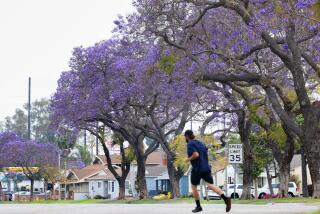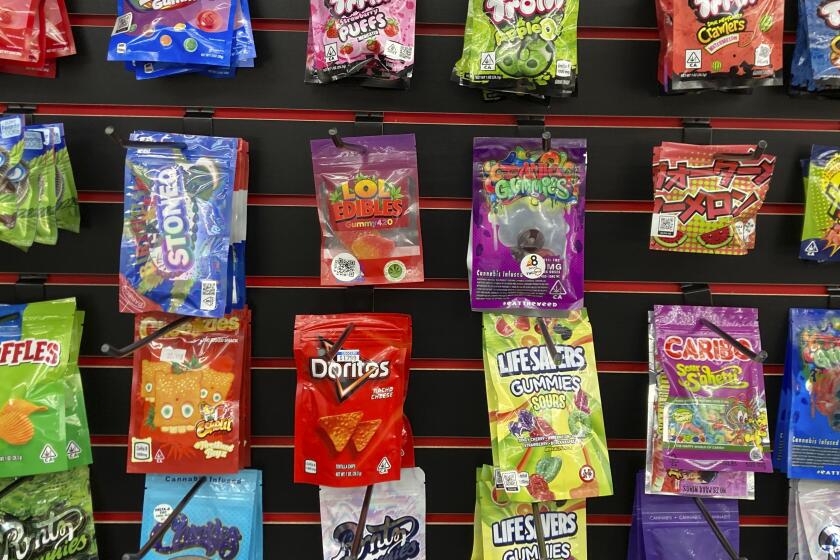Florists are increasingly in lei-away mode during graduation season
After countless years at her craft, Nellie Lua’s fingers have found a rhythm.
The 68-year-old jabs a needle through the bottom of each carnation blossom and tugs the frilly flower along the thread. In 20 minutes, she’s strung 100 blossoms to finish a pink double carnation lei, a popular graduation gift at her store, Island Leis & Bouquets in Carson.
In a year, she and her family will make and sell about 1,000 leis, most of which will adorn the necks of graduates, said her daughter, also named Nellie Lua.
“For graduation, you have to have a lei,” she said. “It’s just normal.”
In recent years, the well-known Hawaiian garland has woven its way into commencement traditions, particularly in California. Along the way, the graduation lei has become a lucrative part of some floral businesses.
The most ubiquitous lei — made of purple dendrobium orchids — is stocked by florists, the Los Angeles Flower Market and even Southland supermarkets. Vendors often set up booths near college campuses to snag last-minute shoppers.
Rosa Kang, owner of flower importer and wholesaler Tropical USA, said she has a contract to provide the leis sold on campus during USC’s commencement. She generally sells about 3,000 orchid leis in cardinal and gold — the school colors. Overall, she said she sells about 5,000 leis a year.
“In the last five years, it really picked up as a graduation item,” Kang said.
She and several sellers say the growing popularity probably stems from the large number of Pacific Islanders in California, who brought the lei-giving custom with them.
The Golden State is second only to Hawaii in terms of the native Hawaiian or and other Pacific Islander population, with 144,000 people, according to the 2010 census data. About a third of them live in Southern California.
“Back in Hawaii, you don’t just have one lei,” said Jean Yoshida, a 76-year-old Hawaii native who lives in Carson. “You have them up to here,” she said, gesturing toward her eyes.
With her other hand, Yoshida cradled plastic boxes containing purple orchid leis from Island Leis & Bouquets.
“It really is tradition,” she said.
Lei awareness has spread to graduates of all ethnicities and backgrounds.
At Island Leis & Bouquets, most of the lei orders come from customers who are not Pacific Islanders, Lua said. The order forms cover a bulletin board behind the cash register, and a nearby refrigerator is stacked with plastic boxes filled with orchid leis of every color.
“Everyone knows Hawaii,” Lua said. “The lei symbolizes the spirit of aloha, which is love. It makes a statement.”
Graduates also like the functionality. Leis are easier to carry than a stiff bouquet of flowers, which can be “a bit of a drag,” Kang said. Also, guys who might balk at clutching a bouquet are more willing to sport a lei.
The growing interest is boosting revenue for florists such as Island Leis & Bouquets, which has seen its lei sales increase by at least 50% since it opened 11 years ago, Lua said. Graduation season, which runs from May to early July, is the store’s most profitable time.
“It keeps us afloat,” she said. “We get weddings and funerals, but graduation season is our big season.”
Some families order directly from Hawaii. At Cindy’s Lei & Flower Shoppe in Honolulu, one of the oldest lei stands in Hawaii, manager Karen Lau Lee said they ship many orders to California, but have also sent leis to states such as Massachusetts, Kentucky and Montana – wherever Hawaii locals attend college.
Prices can range from a $12 for a delicate strand of orchids at the Los Angeles Flower Market to $80 for a bushy double carnation lei at Lua’s store.
Most orchid leis are made in Thailand, then shipped to the U.S., Kang said. Loose flowers and materials for other kinds of leis are sourced from as far as Brazil or Costa Rica (tuberose) or as near as Hawaii (plumeria, kukui nuts).
For something a little more permanent, there are ribbon leis, money leis, candy leis and gummy leis, which are especially popular with elementary school graduates, Lua said. Kang said she’s even seen condom leis.
“You name it. Anything you can think of, they make lei for it,” she said.
For Lua, 40, and her family, lei-making is just as much a business mainstay as a family tradition.
Lua’s father was from Oahu, and his relatives taught the elder Lua how to make leis. She, in turn, taught her daughter.
“I can’t remember when I haven’t known how to make leis,” the younger Lua said as she pulled open a box of ti leaves.
Long work days ending at 3 a.m. are not uncommon during graduation season. For extra help, she’ll call in her cousins, nieces and nephews, all of whom have learned the art of lei-making.
“They have to remember it,” she said. “It’s their culture.”
Twitter: @smasunaga
More to Read
Inside the business of entertainment
The Wide Shot brings you news, analysis and insights on everything from streaming wars to production — and what it all means for the future.
You may occasionally receive promotional content from the Los Angeles Times.











